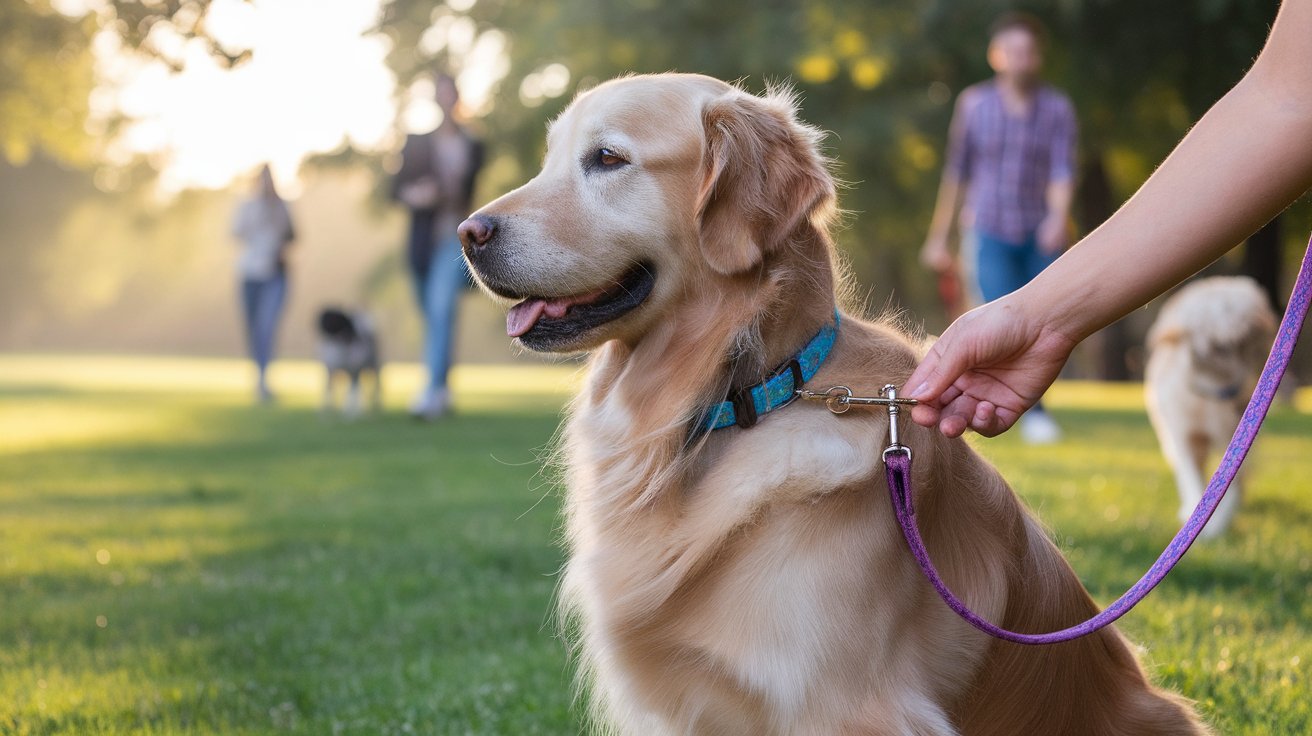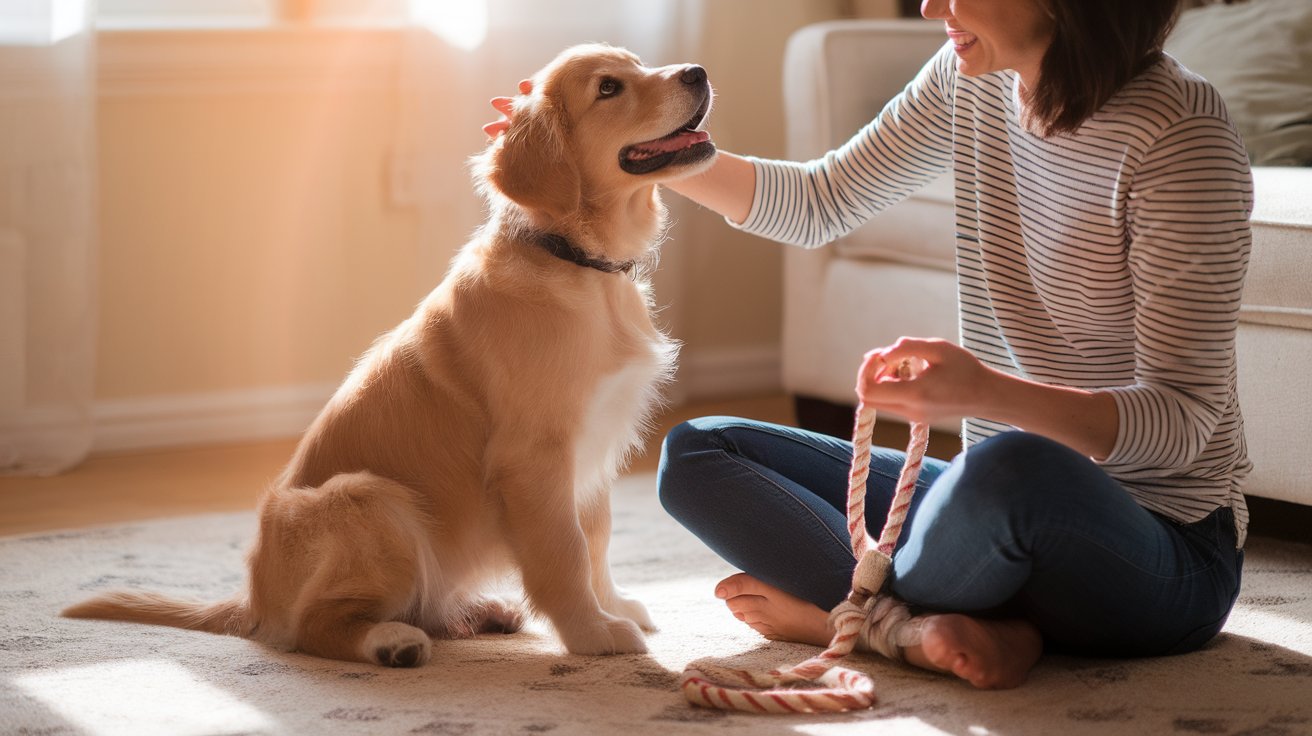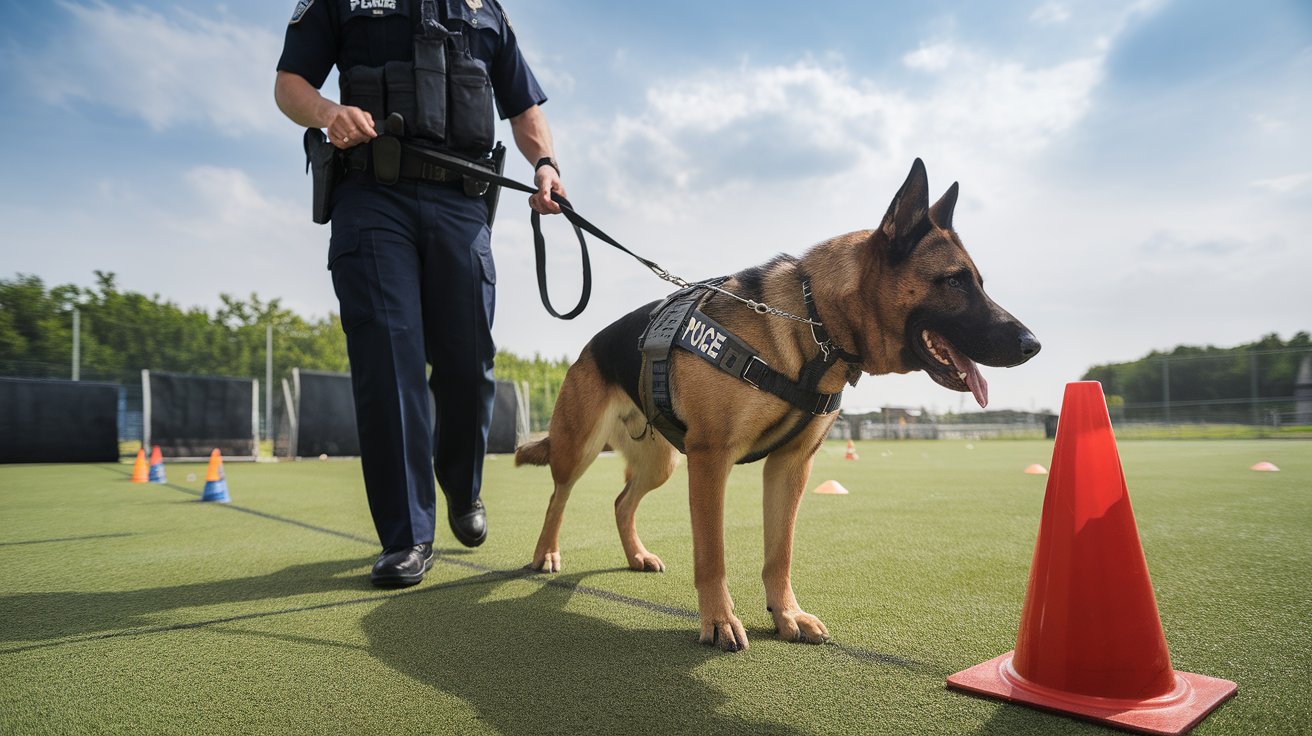Introduction
Ensuring your dog’s collar fits properly is crucial for their safety and comfort. A collar that is too tight can cause irritation, while one that is too loose may let your dog slip out. Whether you’re using a buckle or martingale collar, measuring your dog’s neck size accurately is key. It’s important to adjust the collar regularly to ensure a secure yet comfortable fit, especially as your dog grows or their weight changes. If your dog’s collar doesn’t fit properly, it may lead to discomfort or even injuries, so make sure to double-check its size.
To keep your dog safe, always follow the two-finger rule: the collar should be tight enough to stay secure but loose enough to fit two fingers between the collar and your dog’s neck. If the collar is too loose, your dog can easily escape, which could be dangerous, especially during outdoor activities. Periodic adjustments and close observation can prevent these issues.
Key Takeaways
-
Measuring your dog’s neck size accurately is crucial for ensuring a properly fitting collar that provides both comfort and safety.
-
Using the two-finger rule helps maintain a collar that is snug but not too tight, preventing choking or irritation.
-
Choosing the right tools like a soft measuring tape or string ensures accurate measurements for finding the best collar size.
-
Regularly adjusting the collar as your dog grows or gains weight prevents discomfort or safety risks.
-
Observing your dog’s behavior can signal whether the collar fits properly, indicating when adjustments are needed.
-
Avoid common mistakes like relying on breed size alone or ignoring signs of discomfort, which can lead to poor collar fit.
Measuring Your Dog’s Neck Size
Measuring your dog’s neck size is crucial to ensuring the right size collar for their safety and comfort. A collar that’s too tight can cause discomfort, while one that is loose enough that it doesn’t fit properly might let your dog slip out. To avoid accidents and injuries, it’s essential to find that perfect balance. Whether you’re using a buckle or clasp collar, a martingale, or an adjustable type, the goal is to make it snug but not too tight. Tighten your dog’s collar just enough to stay secure, but leave room to fit an id tag. This simple step can prevent the collar from getting caught on anything during walks or outdoor adventures. Regularly check to see if you need to adjust the fit, especially if the collar gets loose. With a well-fitted collar, your furry friend will stay comfortable and safe.
How to Tighten a Dog Collar and Adjust it Comfortably
-
Use the Two-Finger Rule To ensure your dog’s collar is not too tight or too loose, use the two-finger rule. After fastening the collar, you should be able to easily slide two fingers between the collar and your dog’s neck. This ensures that the collar isn’t so tight that it causes discomfort or restricts breathing, while also being snug enough to prevent your dog from slipping out. Always check this when tightening the collar.
-
Measure the Neck Size Correctly Proper measurement is key to adjusting a collar that fits well. Use a soft measuring tape or a piece of string to measure around the base of your dog’s neck, where the collar will sit. Be sure not to pull the tape too tight—measure it as snugly as the collar should fit. This way, you avoid tightening the collar too much, which could cause irritation or harm.
-
Choose the Right Collar Type Depending on your dog’s size and activity level, select a collar that’s easy to adjust. Buckle collars are adjustable and secure, while martingale collars offer more control for dogs that tend to pull. Make sure the collar you choose can be tightened or loosened easily for a proper fit. Regularly adjust dog collars to maintain comfort, especially if your dog’s weight changes.
-
Check for Signs of Discomfort Pay attention to how your dog reacts to the collar. If they frequently scratch, shake their head, or seem to tug at it, the collar might be too tight. On the other hand, if the collar looks loose or shifts too much, you’ll need to tighten it. Regularly adjusting the collar helps keep your dog safe and prevents discomfort.
-
Regularly Adjust as Your Dog Grows Puppies and growing dogs need frequent collar adjustments. As your dog matures, their neck size changes, so ensure you regularly adjust their collar to avoid it becoming too tight or too loose. Even with adult dogs, periodic checks are necessary, as weight changes can affect the collar fit.
Proper Tools for Measuring
To measure your dog’s neck accurately, you’ll need the right tools. A soft measuring tape is ideal, but if you don’t have one, you can use a piece of string or a shoelace along with a ruler. These tools help you determine the circumference of your dog’s neck, which is crucial for finding the perfect collar. Make sure the measuring tape isn’t too tight or too loose to avoid discomfort or incorrect sizing. For a more precise fit, always double-check your measurements and, if necessary, consult a professional dog trainer for advice on choosing the best collar for your dog’s needs.
Tips for Correct Measurement
Start by gently wrapping the measuring tape around the base of your dog’s neck, where their collar usually sits. Ensure it’s snug but not too tight—you should be able to fit two fingers between the collar and your dog’s neck. If using a string, mark where it overlaps, then measure the string with a ruler. Don’t forget to add an extra inch or two for comfort. This small adjustment will prevent the collar from being too tight, ensuring your dog can wear it without discomfort. Properly fitting your dog’s collar is important for their safety and comfort, helping you avoid issues like a collar that’s too tight or too loose.
Adjusting the Dog Collar
Properly adjusting your dog’s collar is vital for their safety and comfort. If the collar is too tight, it can cause irritation, skin problems, or even affect their breathing. A collar that’s too loose, however, might slip off or get caught, putting your dog at risk, especially when attached to a leash during walks. To avoid this, you should regularly check how tight should a dog collar be and make it smaller if needed, especially as your dog grows or gains weight. Ensuring that the collar fits properly will allow your dog to move freely without discomfort. It’s also important to keep the collar on your dog while at home or outside, as slip collars can provide the best fit when adjusted correctly. Checking and adjusting the collar periodically will keep your pet safe and happy.
Case Study: Adjusting a Dog Collar for Maximum Comfort and Safety
A recent case study conducted by a veterinary clinic in San Francisco highlighted the importance of correctly adjusting a dog’s collar for both safety and comfort. The study involved 50 dogs of various breeds and sizes, all of whom were brought to the clinic due to collar-related issues such as skin irritation, discomfort, or injury. Upon examination, it was found that 40% of the cases were caused by collars that were too tight, leading to skin rashes and breathing difficulties, while 30% of the dogs had collars that were too loose, increasing the risk of the collar slipping off during walks.
The study demonstrated that using the two-finger rule when adjusting collars significantly reduced these problems. Pet owners who regularly checked their dogs’ collars, especially after growth spurts or weight changes, saw fewer incidents of irritation and injury. This emphasizes the importance of routinely adjusting and fitting collars properly to ensure your dog’s comfort and safety.
Loosening or Tightening the Collar
After measuring your dog’s neck, adjusting the collar to the right size is the next step. If you find the collar is too tight, loosen it slightly to avoid choking or discomfort. A collar that is too loose, however, can lead to your dog slipping out of it or getting caught on something, especially in outdoor environments. Using an adjustable collar, such as a buckle or martingale collar, can make fine-tuning easier. You should always make sure the collar is tight enough to stay secure, but loose enough to fit two fingers between the collar and your dog’s neck, ensuring both safety and comfort.
Ensuring Proper Placement
Beyond adjusting for tightness, it’s important to position the collar properly on your dog’s neck. Ideally, the collar should sit just below their jawline, not too close to their throat or shoulders. The placement will help prevent any rubbing or irritation as they move around. Also, ensure that the collar is flat against the skin without pinching or folding. Regularly check the fit, especially after walks or play sessions, as collars can shift or loosen. If the collar is in the right position, your dog will be able to wear it comfortably while staying secure during outdoor adventures or everyday activities.
Checking for Comfort and Fit
Ensuring your dog’s collar is comfortable and fits properly is key to their well-being and safety. A collar that’s too tight can cause discomfort or even injury, while one that’s too loose may lead to your dog slipping out. The goal is to find that perfect balance where the collar stays secure but doesn’t restrict your dog’s movement or cause irritation. Regularly checking the fit, especially after your dog has been active or as they grow, helps prevent any long-term issues. With the right fit, your dog can enjoy their walks and daily activities safely and comfortably, without any concerns about their collar causing harm.
Ensuring Two-Finger Rule
One simple and effective way to check if your dog’s collar fits well is by using the two-finger rule. After securing the collar around your dog’s neck, try slipping two fingers between the collar and their skin. If you can fit two fingers comfortably, it’s likely the collar is neither too tight nor too loose. This method ensures that your dog won’t experience choking or irritation, while also preventing the collar from being too loose, which could lead to your dog slipping out of it. Regularly using this rule helps maintain a proper fit as your dog grows or if they gain or lose weight.
Observing Your Dog’s Behavior
Another key indicator of whether a collar fits comfortably is your dog’s behavior. If your dog frequently scratches at their collar, shakes their head, or seems distressed, these could be signs that the collar is too tight or irritating their skin. On the flip side, if your dog can easily slip out of the collar or if it moves around too much, it’s likely too loose. Watching how your dog behaves during walks or playtime can help you gauge if the collar is properly fitted. Adjusting the collar based on these observations will keep your dog comfortable and safe, allowing them to enjoy their activities without discomfort.
“An animal’s eyes have the power to speak a great language.” – Martin Buber
Common Mistakes to Avoid
When it comes to dog collars, ensuring a proper fit is not only about comfort but also safety. Many pet owners make simple mistakes that can lead to discomfort or even injury for their dogs. Whether it’s neglecting the signs of discomfort or using improper sizing methods, these common errors can be avoided with a bit of care and attention. Taking the time to get the right fit for your dog’s collar will enhance their safety during walks and ensure they feel comfortable wearing it throughout the day. By avoiding these mistakes, you can keep your furry companion safe, secure, and happy.
Overlooking Signs of Discomfort
One of the most common mistakes dog owners make is overlooking signs that their dog is uncomfortable with their collar. Behaviors like constant scratching, whining, or even trying to remove the collar are strong indicators that something is wrong. A collar that is too tight can cause irritation, while a collar that’s too loose can create a risk of the dog slipping out. It’s important to check regularly for signs of discomfort and make adjustments as needed. Ensuring the collar fits properly will not only make your dog more comfortable but also prevent accidents during outdoor activities.
Using Incorrect Sizing Techniques
Another frequent issue is selecting the wrong collar size due to improper measurement techniques. Many dog owners assume that certain breeds have standard neck sizes, but each dog’s build can be unique. Relying solely on general breed guidelines may result in an ill-fitting collar. Instead, it’s essential to measure your dog’s neck circumference accurately before choosing a collar. This ensures a snug but comfortable fit that won’t irritate or pose a choking hazard. Using proper sizing techniques can prevent issues such as the collar being too tight or too loose, both of which can cause discomfort and pose a safety risk for your dog.
Conclusion
Ensuring your dog’s collar fits just right is key to keeping them safe and comfortable. A collar that’s too tight can cause irritation or even breathing problems, while a loose collar can lead to your dog slipping out, especially when outside. That’s why it’s super important to tighten a dog collar just right—tight enough to stay secure, but not so tight that it causes harm. Keep checking and adjusting as needed because dogs grow, gain weight, or lose weight, and the collar needs to keep up.
It’s also important to pick the right collar for your dog. Whether it’s a buckle or martingale collar, using the right size and regularly measuring your dog’s neck ensures a proper fit. Follow the two-finger rule to make sure the collar isn’t too loose or tight. Adjust dog collar checks should be done regularly to make sure it’s not causing discomfort. This way, whether your dog wears a dog harness or a collar, they stay safe and comfortable during walks and everyday fun!














